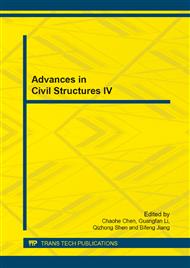p.762
p.767
p.772
p.776
p.779
p.784
p.790
p.797
p.801
Progressive Collapse Analysis of CFST Frame with Semi-Rigid Connection
Abstract:
A finite element method was developed to investigate the semi-rigid connection mechanical behaviors in the process of CFST structures progressive collapse, and different semi-rigid connection joint stiffness were taken into consideration and compared to rigid connection. Nonlinear static and dynamic analysis were carried out with alternate path method. The numerical result shows that the increase of joint stiffness would evidently enhance the structural progressive collapse resistance performance, and CFST structures have excellent characteristic to prevent progressive collapse, the great deformation capacity and energy dissipation ability of semi-rigid connections are advantageous to progressive collapse resistance.
Info:
Periodical:
Pages:
779-783
Citation:
Online since:
July 2014
Price:
Сopyright:
© 2014 Trans Tech Publications Ltd. All Rights Reserved
Share:
Citation:


